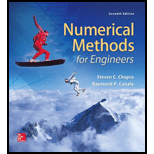
Concept explainers
The velocity of water flow through the porous media can be related to head by D'Arcy's law
where K is the hydraulic conductivity and
To calculate: The water flowsvelocity through the porous media for the Prob. 32.8, if the hydraulic conductivity is
Answer to Problem 9P
Solution:
The water flow velocity at every node is,
| -5.205E-04 | -5.542E-04 | -6.593E-04 | -7.249E-04 |
| -5.079E-04 | -5.315E-04 | -6.989E-04 | -7.942E-04 |
| -4.668E-04 | -3.967E-04 | -4.429E-04 |
Explanation of Solution
Given Information:
Write the expression for D’Arcy’s law.
Here,
The hydraulic conductivity is
Formula used:
Consider the Laplace Equation,
Write the central difference approximation for the second derivative.
Calculation:
Refer to Figure P32.8, draw the nodal diagram.

Recall the Laplace Equation,
The central difference approximation applies for the second derivative in above Laplace equation,
At the node,
Approximate the all external nodes with a central finite difference,
Thus,
Now with a central finite difference, approximate the external nodes.
Solve further,
Substitute (3) and (4) in (2).
Similarly, at the node,
Similarly, at the node,
Similarly, at the node,
Similarly, at the node,
Similarly, at the node,
Similarly, at the node,
Similarly, at the node,
Similarly, at the node,
Thus, the system of all linear equations is,
And,
And,
Write all equation in matrix form.
Use the MATLAB to solve the above equations, write the following code in MATLAB.
The output is,
Thus, the distribution of head of the system is shown below.
| 16.3372 | 17.37748 | 18.55022 | 20 |
| 16.29691 | 17.31126 | 18.4117 | 20 |
| 16.22792 | 17.15894 | 17.78532 |
Now from the above table find the value of
And
Calculate the value of
And,
Calculate all the value of
| 1.04029 | 1.10651 | 1.31126 | 1.44978 |
| 1.01435 | 1.05740 | 1.34437 | 1.58830 |
| 0.93102 | 0.77870 | 0.62638 |
Calculate the value of
Calculate all the value of
| 0.04029 | 0.06623 | 0.13852 | 0.00000 |
| 0.05464 | 0.10927 | 0.38245 | 0.00000 |
| 0.06898 | 0.15232 | 0.62638 |
Now calculate the value of
Substitute the values of
For
Calculate for every node the value of
| 1.04107 | 1.10849 | 1.31855 | 1.44978 |
| 1.01582 | 1.06303 | 1.39771 | 1.58830 |
| 0.93357 | 0.79345 | 0.88583 |
Apply the D’Arcy law to find the discharge velocity in the n direction:
Here,
Now Calculate for the velocity (
Calculate the velocity for every node same way, and got the following table:
| -5.205E-04 | -5.542E-04 | -6.593E-04 | -7.249E-04 |
| -5.079E-04 | -5.315E-04 | -6.989E-04 | -7.942E-04 |
| -4.668E-04 | -3.967E-04 | -4.429E-04 |
Want to see more full solutions like this?
Chapter 32 Solutions
Numerical Methods for Engineers
 Mathematics For Machine TechnologyAdvanced MathISBN:9781337798310Author:Peterson, John.Publisher:Cengage Learning,Algebra & Trigonometry with Analytic GeometryAlgebraISBN:9781133382119Author:SwokowskiPublisher:Cengage
Mathematics For Machine TechnologyAdvanced MathISBN:9781337798310Author:Peterson, John.Publisher:Cengage Learning,Algebra & Trigonometry with Analytic GeometryAlgebraISBN:9781133382119Author:SwokowskiPublisher:Cengage Trigonometry (MindTap Course List)TrigonometryISBN:9781337278461Author:Ron LarsonPublisher:Cengage Learning
Trigonometry (MindTap Course List)TrigonometryISBN:9781337278461Author:Ron LarsonPublisher:Cengage Learning



